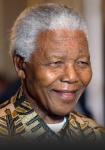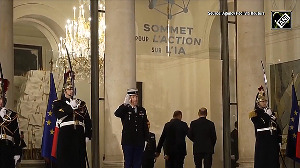The proposed funding for the defence forces in the Union Budget presented by Finance Minister P Chidambaram has come into effect on April 1. On the face of it, the Budget appears to be a customary fiscal exercise to deflect the usual inflationary trends.
However, one had expected the allocation to cross the Rs 100,000 crore (Rs 1,000 billion) mark for 2007-08 but the finance minister somehow managed to peg the figure at Rs 96,000 crore (Rs 960 billion) which is 14.11 per cent of total central government expenditure.
The previous year's allocation was Rs 83,000 crore (Rs 830 billion) out of which the ministry of defence surrendered an unutilised amount of Rs 4,000 crore (Rs 40 billion). It's quite possible that at the end of the current financial year too, a similar large sum may remain unspent to fall back into the government coffers due to snags in the kickback-infected defence acquisition procedures.
Incidentally, the military spending remains in the vicinity of 2.5 per cent of our annual gross national product. On the other hand, Pakistan allocates 5 per cent of its GDP on its defence establishment while China spends more than 7 per cent of its galloping GDP on its armed forces.
Currently engaged in a frenzied drive towards the modernisation of nearly 2.5 million men with arms, Beijing which deploys a large chunk of its PLA forces on our northern Himalayan borders, has just announced an 18 per cent hike in its defence budget to $45 billion, more than double India's projected allocation of approximately $ 20 billion. In fact, China's true military spending is believed to be much higher than the reported figure, which does not include weapons purchases and other key items.
The Budget rightly cited the modernisation mantra as the reason for the hike. The finance minister has also enhanced appropriation under the 'capital' head, with an outlay of Rs 41,922 crore (Rs 419.22 billion), compared to last year's Rs 37,458 crore (Rs 374.58 billion). This indicates the government's eagerness to modernise the defence set up by boosting the combat services' firepower.
The enhanced amount is supposed to be utilised for the procurement of fighting and support hardware for the forces. A large part of this sum is likely to be earmarked for payments of Russian aircraft carrier Admiral Gorshkov, 66 British Hawk jet trainers and six French Scorpene submarines. The government may also sign a huge contract for the purchase of 126 multi-role combat aircraft for the Air Force. There is no doubt that archaic combat equipment on the inventory of the three services need replacement.
A large portion of the defence outlay amounting to Rs 54,078 crore (Rs 540.78 billion) is mostly spent on salaries and general maintenance of military assets leaving precious little for training and operational preparedness. This amount will go up considerably once the Sixth Pay Commission's recommendations are submitted and implemented.
While the army's share of the defence budgetary cake comes to Rs 45,685 crore (Rs 456.85 billion), the Air Force and Navy get Rs 27,022 crore (Rs 270.22 billion) and Rs 17,529 crore (Rs 175.29 billion), respectively.
The DRDO with a mediocre and tardy record for developing modern weapon systems for the services, has been given Rs 5,887 crore (Rs 58.87 billion), a hike of Rs 434 crore (Rs 4.34 billion) from the last year's allocation. A major portion of the sum earmarked for it is a sheer waste as the armed forces prefer to induct the latest proven combat hardware from foreign sources rather than opt for indigenously designed weaponry and delivery platforms developed at an exorbitant cost.
The Parliament's Public Accounts Committee (PAC) as well as the standing committee on defence have pulled up the DRDO for serious procedural lapses in purchase of laboratory systems. In its 14th report tabled in Parliament last month, the standing committee noted that the massive time and cost overruns associated with the DRDO's projects have dealt a blow to defence modernisation. The organisation has been advised to discontinue research work in areas such as food, agriculture, medicine and psychology and concentrate on vital aspects of defence R&D.
In order to economise, the three services, particularly the manpower rich Army should give a serious thought to their man-machine mix and take steps towards automation in combat and support services.
Why not have common support services like communications, medical, ordnance and supply for the Army, Navy and Air Force by merging them? This would reduce the tooth-to-tail ratio that is much higher compared to modern western armies. In today's times, uniformed men running farms and veterinary services is a wasteful exercise and totally out of context. The parameters of the futuristic push-button warfare will require considerable downsizing of the nearly 1.4 million men in uniform.
The augmentation and greater utilisation of the Territorial Army, a part time citizens' force could also be given serious thought. In the event of the salary and maintenance bill shooting up considerably and highly expensive weapons systems getting remote-controlled and automated, the armed forces may have to devise suitable operating procedures wherein they get maximum firepower with less manpower. Deploying electronic surveillance systems on the border in place of manned sentry posts could be an alternative.
The defence of a nation is much more than the mere deployment of military formations on its international borders. It is also about ensuring the protection of our national interests as well as of our large expatriate work force especially those deployed in the world's volatile regions.
Provisions have to be made to equip and train our armed forces for such onerous tasks during contingencies. In view of the rapid modernisation drive by the nuclear armed Chinese forces and the frenzied test-firing of India-specific nuclear capable missiles by Pakistan, India has to allocate sufficient funds to neutralise the looming threats by effectively operationalising its deterrent as envisaged in the nation's nuclear triad.
The mere increase of Rs 10,000 crore (Rs 100 billion) over the last year's budgeting with a nominal hike in capital spending will not suffice to accomplish this vital objective of national security.







 © 2025
© 2025